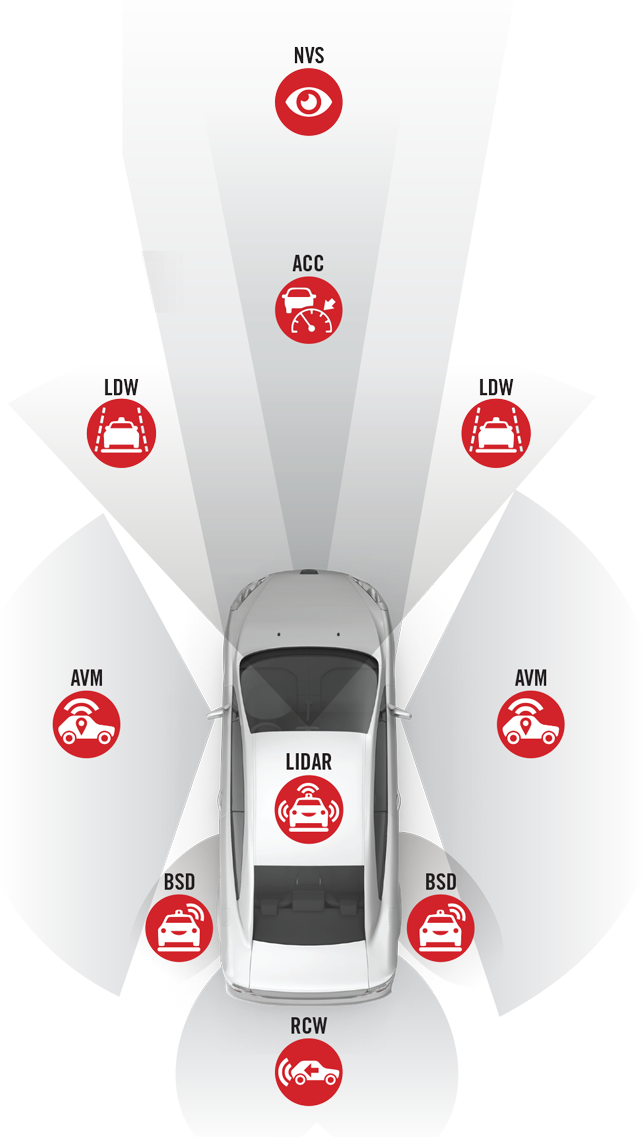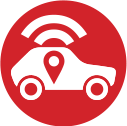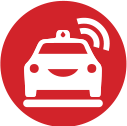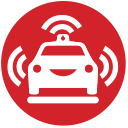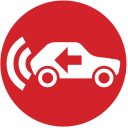AUTEL LDW20T - Standard Frame - Lane Departure Warning All Systems with MS909 Tablet
AUT-LDW20TNew AUTEL ADAS Standard Frame Lane Departure Warming All Systems Package With MS909 Tablet - LDW20T, The 2.0 Version
What is included |
|
|
|
|
|
|||||||||||||||||||||||||||||||||||
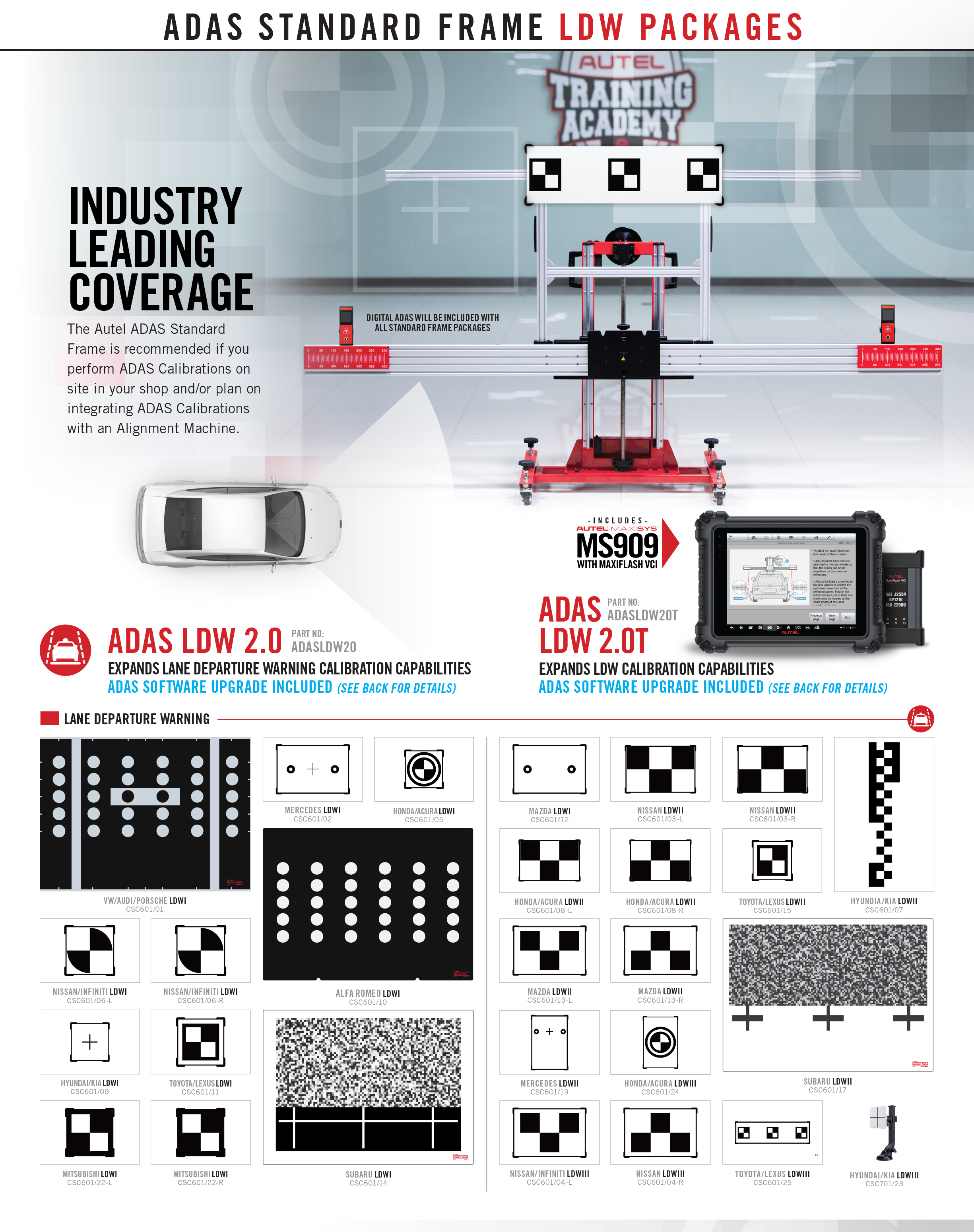
FREQUENTLY ASKED QUESTIONS
-
What is ADAS?
The Advanced Driver Assistance System (ADAS) uses image processing cameras, radar, light detection and ranging and other sensors to monitor vehicle surroundings and detect potentially dangerous situations. Purpose: to increase safety through advanced situational awareness and reduce collision possibilities.
Sensors used in ADAS include cameras, radars, lasers and ultrasound. They can detect light, heat, pressure and other variables used to monitor the state of vehicle. Usually they locate in the front and rear bumpers, side mirrors, vehicle cab and wind shield glasses.
-
What are the applications of ADAS?
ADAS usually includes Traffic Message Channel (TMC), Intelligent Speed Adaptation (ISA), Vehicular Communication Systems and other driver assistant systems. The specific systems are as follows:
- Vehicle Cab:
1) Lane Departure Warning System
2) Lane Keeping Assist
3) Traffic Sign/Signal Recognition
4) Night Vision System
5) Driver Status Monitor
6) Electric Vehicle Warning
7) Hill Descent Control
- Front:
1) Parking Assist
2) Adaptive Front/Lighting System
3) Adaptive Cruise Control
4) Pedestrian Detection
5) Emergency Brake
- Rear:
1) Reverse Image
2) Parking Assist
3) Rear Collision Warning
- Side:
1) Surround View
2) Blind Spot Detection
-
When to use ADAS?
Under normal circumstances, after repair in an accident, calibration of the relevant auxiliary systems need to be performed. When disassembling or reinstalling monitoring components such as cameras, radars, and sensors, replacing the vehicle ECU, or the vehicle height has been changed, auxiliary and other systems need to be calibrated.
For example: ACC calibration needs to be performed in the following cases.
1. Repair or replace the Adaptive Cruise Control (ACC) radar sensor control unit
2. ACC radar sensor deviation angle out of normal range
3. Adjust position of the ACC radar sensor on the vehicle body
4. Repair or replace bumper or radiator grill
5. Adjust chassis
-
How to use MaxiSys ADAS?
Perform the following steps prior to setting-up calibration toolset.
? Park the vehicle on a flat and level surface with its front wheels pointing straight and ensure there are no objects
in front of the vehicle.
? The vehicle’s coolants and engine oil should be at recommended levels and the gas tank full. The vehicle should
not be carrying any load (passengers or cargo).
? Attach the VCI to the vehicle and connect the diagnostic tool to the vehicle (if connected through cable, please
pass cable through window).
? Close the vehicle doors.
? Adjust the tire pressure to the recommended value.
? The preparation measures vary by vehicle and system. Please follow the instructions on the MaxiSys ADAS
tablet to ensure accurate calibration.
-
What is ADAS Front-view Camera?
The front-view camera captures what is in front of the vehicle. It is used in a number of ADAS systems, including Lane Departure Warning (LDW), Lane Keeping Assist (LKA) and Traffic Sign/Signal Recognition (TSR) systems, often in conjunction with other sensors, cameras or sensing systems to provide input data.
-
What is ADAS 360°Camera?
The 360° or Surround View Camera System uses multiple camera views to create one 360° top-down (bird’s eye) view surrounding the vehicle. This system is used in both passive (displayed instructions) and active (autonomous) vehicle parking assist systems.
-
What is ADAS Radar Sensor?
ADAS radar sensors detect fixed and moving objects at different distances around the perimeter of a vehicle. Different Radar types and frequencies are used in various ADAS systems. Ultra short-range radar (USRR) and short-range radar (SRR) provide data for blind-spot detection (BSD) and lane-change assist (LCA), while systems including adaptive cruise control (ACC) use longer range radar.
-
How can I get the ADAS software?
To get the valuable ADAS calibration software, you can purchase the MaxiSys ADAS tablet or purchase the ADAS calibration software upgrade for your existing MaxiSys tablet.
-
What are the technology tools of ADAS and where are they in my vehicle?
Cameras, sensors, ultrasound, radar and LIDAR are some of the systems used to capture the driving environment data, including travelling or static vehicles position, pedestrian location, road sign, driving lane and intersection detection, road (curves) and driving conditions (poor visibility or evening driving), use that information to instruct the vehicle to take its predetermined action. Cameras, sensors and sensing systems are typically location in front and rear bumpers, windshield, front grill and side and rear view mirrors.
-
What if my car is not in a horizontal position?
ADAS calibration procedures should be performed on a level floor. If an alignment lift is used for leveling, the Autel calibration software can provide adjustment information and the calibration frame can be easily raised or lowered to be level with the vehicle.
-
Which areas does Autel MaxiSys ADAS support?
The MaxiSys ADAS currently supports calibrations for most today’s ADAS-enabled vehicles in the USA, Asian, European markets.
-
What are the requirements for the calibration shop?
1.Perform calibration procedures indoors without object obstructions
2.No exterior light sources to cast uneven surface shadows
3.Some procedures require bright background light alignments
-
What are the requirements for the calibration surface?
Park the vehicle on a flat and level surface with its front wheels pointing straight and ensure there is room around the vehicle (generally there should not be objects within three meters or ten feet of the front of the vehicle).
-
Why is MaxiSys ADAS a comprehensive solution?
Based on the powerful MaxiSys platform, Autel presents the MaxiSys ADAS. The MaxiSys ADAS not only provides the original complete diagnostic functionality but also offers comprehensive and precise ADAS calibration.
Combined with the best possible OE-level diagnostic coverage, the MaxiSys tablet has evolved far beyond our original tool capabilities to offer complete ADAS and diagnostic solutions for smarter repair and calibration.
A: Comprehensive Functionality
1.The MaxiSys ADAS offers all diagnostic and maintenance services of the MaxiSys tool.
2.The MaxiSys ADAS’s ADAS module covers many vehicle makes, including Benz, BMW, Audi, VW,
Porsche, Infiniti, Lexus, GM, Ford, Volvo, Toyota, Nissan, Honda, Hyundai and Kia.
3.The MaxiSys ADAS supports the calibration of multiple driver assistant systems, including Adaptive Cruise
Control (ACC), Night Vision System (NVS), Lane Departure Warning (LDW), Blind Spot Detection (BSD),
Around View Monitoring (AVM), Rear Collision Warning (RCW) and Heads-up Displays (HUD).
4.The MaxiSys ADAS supplies graphic illustrations and step-by step instructions.
5.The MaxiSys ADAS provides demos to guide the technician through the calibration.
B: Complete Tools
While the calibration procedures vary by make and the tools differ by driver assistant system, the MaxiSys ADAS calibration toolset can fulfil the flexible installation and precise calibration for a wide range of vehicle makes and systems.
1.The calibration toolset allows flexible assembly for different driver assistant systems and vehicle models.
2.The calibration frame is equipped with a sliding board for easy movement and positioning.
3.The toolset provides calibrations with millimeter accuracy via the precise marks on rulers and
the laser positioning.
-
Which vehicle actions require ADAS system diagnostics or ADAS sensor calibration?
Sensor Replacement / Accident Repair / Wheel Alignment / Windshield Replacement / Diagnostic Service
-
What is the easiest way to check the vehicle to confirm which ADAS modules are active?
During the Pre-SCAN procedure, the MaxiSys software will scan all modules in all systems and list on a single screen, then provide visual ADAS icons next to the active ADAS modules. This shows technicians which ADAS systems are active and helps prepare a more detailed repair plan which includes the required ADAS calibration procedures after the repairs are complete.
-
How do I know if the ADAS recalibration was successful?
The technician can review the post-calibration scan to confirm if the module DTC is cleared. The ADAS module calibration will not complete if the calibration steps were not followed correctly.
-
What are the different types of ADAS calibrations and are they brand specific?
Depending on vehicle type, either a Stationary or Dynamic calibration procedure is required (in some vehicle types both are required) to calibrate ADAS sensors to vehicle modules.
• Stationary calibrations are completed in a shop environment and requires the use of targets or patterns to complete.
• Dynamic calibrations require the vehicle to be driven on roadways for a certain amount of time with well maintained road markings.
-
What are the shop environment requirements for calibration procedures?
• Flat and level surface with enough room around the vehicle to complete calibration procedures. (generally, there should not be objects within the 15 foot by 30 foot calibration area)
• Perform calibration procedures indoors without object obstructions.
• No exterior light sources to cast uneven surface shadows.
• Some procedures require bright background light alignments.
-
What vehicle preparation is required before performing calibration procedures?
• The vehicle coolants and engine oil should be at recommended levels and the gas tank full.
• The vehicle should not be carrying any load (passengers or cargo).
• Adjust the tire pressure to the recommended value.
• Attach the wireless VCI to the vehicle DLC.
• Make sure the MaxiSys is paired to the VCI, then make sure to close all the vehicle doors.
• Establish communication from the diagnostic tool to the vehicle.
• Follow the MaxiSys ADAS software instructions to ensure accurate calibration. Preparation measures vary by vehicle and system.
-
How do I know what patterns and calibration procedures to use?
The Autel MaxiSys ADAS Calibration Application software provides graphic step-by-step instructions that are vehicle model specific to confirm the correct patterns are used during the correct calibration procedures. Your MaxiSys software confirms this information is correct, based on the vehicle information confirmed from the AutoSCAN feature, to confirm which active ADAS modules in any vehicle system may need a calibration procedure completed.
-
Does the MSADAS tablet provide other scan tool functions than ADAS calibration?
a. Yes, the MSADAS provides all the same diagnostic and maintenance services as the MS908SP, including Pre / Post Scanning
-
Do I need a new scan tool for ADAS calibration, if I already have an existing MS908 / MS908P / MS908S / MS908SP / MS908E?
a. You can purchase an ADAS UPGRADE to add ADAS capabilities to your existing Autel MaxiSys scan tool.
b. If you do not have an Autel scan tool, then you should purchase an MSADAS scan tool package for best value.
-
Can I purchase just the ADAS application upgrade without the calibration frame to complete ADAS calibration procedures?
a. No, the MaxiSys ADAS application requires a code (QR code scan) from the calibration frame to activate the software.
For more information, see 'ADAS Frame Banding' on the DOWNLOAD page.
-
If I want to add individual targets or calibration tools later, are they available for purchase?
a. Yes, the specialty fixtures, existing targets and new vehicle coverage targets are available for individual purchase.
-
Depending on which vehicle systems I am concerned with, which ADAS calibration kit should I purchase?
a. LDW, LKA, ACC (forward looking only) - You need the LDW kit (ADS-LDWPACKAGE)
b. AVM, RCW, RCA (around view / 360 view / rear looking) - You need the Complete Kit (ADS-ADASCOMPLETE)
c. Night Vision, Radar (includes Blind Spot etc.) - Also in the Complete Kit (ADS-ADASCOMPLETE)
*can be added as additional accessories to the LDW kit
-
Do I need someone to assemble and or set up the calibration frame?
a. No, the complete assembly is a simple 20-25 minute process. Graphic instruction and standard screws are included.
-
Are training options necessary for working on ADAS calibrations?
a. No, The MSADAS software features step by step illustrated instructions for placing the calibration frame and targets.
b. If a customer requests general ADAS training, I-CAR, CTI, and AutoTech have ADAS classes utilizing the Autel tool.
-
What are insurance companies paying for calibrations?
a. Insurance companies are typically paying between $200 and $300 for each ADAS calibration.
b. The ADAS application also provides the Pre and Post-SCAN features, which insurance companies pay $100-$150 for.
-
Other than a clear 30 foot x 15 foot area, what are the other working shop bay requirements to complete ADAS calibrations?
a. No obstructions or 2 post lifts. An alignment bay will work if there is approx. 9 1/2’ between the frame and lift
b. Level floor in the bay or the lift being level at 3 foot or lower.
c. No “checker board” or other geometric patterns on the walls or floor
d. Able to close bay door and or block exterior light sources that cast uneven surface shadows
-
What are the different types of ADAS calibrations and are they brand specific?
Depending on vehicle type, either a Stationary or Dynamic calibration procedure is required (in some vehicle types both are required) to calibrate ADAS sensors to vehicle modules.
• Stationary calibrations are completed in a shop environment and requires the use of targets or patterns to complete.
• Dynamic calibrations require the vehicle to be driven on roadways for a certain amount of time with well-maintained road markings.
-
Can I activate multiple tool ADAS applications from one calibration frame?
a. No, the activation “bonding” is unique to a single ADAS application tool from the Autel ADAS calibration frame.
b. You can use an “activated” ADAS application tool with any Autel ADAS calibration frame.
For more information, see 'ADAS Frame Banding' on the DOWNLOAD page.
-
Does the MSADAS tablet provide other scan tool functions in addition to ADAS calibration?
a. Yes, the Autel MaxiSYS ADAS Tablet includes all of the diagnostic and maintenance functions as the Autel MaxiSYS MS908SP, including Pre & Post-SCAN reporting and J-2534 programming interface
-
Can I activate multiple ADAS-Capable tablets with one calibration frame?
a. Yes, you can add multiple ADAS capable tablets to your calibration frame. However, only one type of calibration frame can be activated on each tablet. Be sure to select the correct calibration frame as this selection cannot be un-done and two version of the ADAS software cannot reside on the same tablet.
-
Can I purchase just the ADASUPGRADE without the calibration frame to perform ADAS calibration procedures?
a. Yes, however, a large portion of vehicles require static calibrations, where special equipment is placed around the vehicles at specified locations. Remember, the tool will ask which type of calibration frame you are using when you add the ADAS software. If you don’t have a calibration frame yet, select the option you would most likely get.
-
What are the different types of ADAS calibration and are they brand specific?
a. There are two types of ADAS calibration, STATIC and DYNAMIC. The type of calibration required is determined by the vehicle manufacturer.
- STATIC CALIBRATIONS are performed in the service bay using vehicle specific targets and patterns. Static calibrations require controlled conditions, such as bright even lighting, flat level floor, no clutter behind the targets, etc.
- DYNAMIC CALIBRATIONS are performed while driving the vehicle under very specific conditions determined by the vehicle manufacturer. These conditions include, calibrating during the day, clearly visible lane markings, clear weather conditions, specific driving speeds, flat roads with minimal hills or curves, minimal traffic, etc.
-
Which vehicle actions require ADAS system diagnostics or ADAS sensor calibration?
a. ADAS sensor or camera replacement, collision repair, four wheel alignment, changes in ride height (within vehicle manufacturer’s specifications), windshield replacement, certain mechanical repairs which require the removal of bumper covers, grill, etc., ADAS related diagnostic service, ADAS sensor or camera removed and reinstalled or changes in tire size (within vehicle manufacturer’s specifications).
-
What is the easiest way to check the vehicle to confirm which ADAS module are active?
a. Performing a Pre-Scan with your Autel MaxiSYS will provide a list of all modules currently communication of the vehicle data network. An ADAS icon will display next to a module with ADAS functionality.
-
Does the calibration frame require assembly?
a. Yes, frame assembly is a simple 20-25 minute process. Illustrated instructions, hardware and required wrenches are included. We also have an assembly video on the www.maxisysadas.com website.
-
How do I know what patterns and calibration procedures to use?
a. The Autel MaxiSYS ADAS software displays vehicle specific illustrated step-by-step calibration instructions, which include a list of all needed targets, patterns and accessories required to complete the calibration.
-
What vehicle preparation is required before performing calibration procedures?
a. The Autel MaxiSYS ADAS software will provide a detailed list of vehicle manufacturer specific calibration preparation instructions. The preparation requirement vary by vehicle make. Some common calibration requirements include:
- Vehicle must be parked on flat, level surface
- All fluids must be filled to the recommended levels, e.g. oil, coolant, etc.
- The fuel tank must be full
- Tire pressure must be set to placard level
- No passengers or additional load in the vehicle
- All doors and hood must be closed
- Connect an auxiliary battery power supply
-
How do I know if the ADAS recalibration was successful?
a. At the end of the calibration procedure the Autel MaxiSYS will display a screen indicating the calibration completed successfully. It is a good idea to perform a screenshot at this point and attach this screen to your post scan report. On some vehicle makes calibration parameters will be added to the post-SCAN report which indicate the accuracy of the calibration.
-
What are insurance companies paying for calibrations?
a. Insurance companies are typically paying between $200 and $300 for each ADAS calibration.COST / COMPENSATION / CYCLE TIME DEALER MOBILE REMOTE IN-SHOP TOOL COST TO SHOP $275 $200 $150 --- INSURER COST $300 $300 $300 $300 CYCLE TIME 2 DAYS 1 DAY 2 HOURS 1/2 HOUR
b. The ADAS application also provides the Pre and Post-SCAN features, which insurance companies pay $100-$150 for.
SHIPPING QUOTE
All ADAS frames (portable and full frames) require a shipping quote when ordering. Please keep this in mind when ordering any and all ADAS products. We will require an additional and separate payment for freight charges. We strongly recommend shipping ADAS products to a commercial location with a loading dock. Liftgate services are available for an extra fee if no liftgate is available.
If for any reason you need assistance or have concerns that need to be addressed please don't hesitate to call us directly at 919.408.7320. We will be more than happy to assist you.







